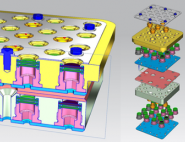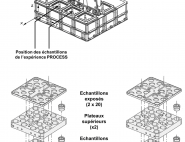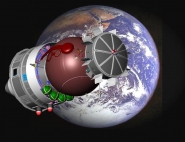Experiments
PROCESS and AMINO Experiments
These two astrochemistry experiments are supported by CNES and consist in studying the degradation of organic molecules of planetological and exobiological interest, when exposed to solar UV. For the first time, sealed cells are used in space. They enable to collect volatiles from refractory molecules degradation, or to irradiate gas mixtures. These cells are designed and manufactured with CNES support.
Generaly, these experiments objective is to measure photolysis kinetics of the exposed products, and thus to estimate their photochemical lifetime when exposed to solar radiation.
The initial device by ESA is designed to use open cells, vented to space, which leads to the loss of volatile products from the degradation the solid organic compounds deposited on MgF2 or quartz windows. Our objective being partly to study the gas products of the degradation, or the study of the evolution of gas mixtures, COMAT (Toulouse) designed sealed cells for us with CNES support, enableing to keep and then bring back on Earth the solid and gaseous phases after photolysis for analyses. The tightness test realised at the beginning of 2007 on these sealed cells shown that they were sufficiant for experiments of a few weeks of the UVolution kind, but they were not adapted to long duration exposition such as PROCESS and AMINO experiments. Thus CNES entrusted the realisation of the new ultra-airtight cells used in 2008 for AMINO experiment to Air Liquide advanced techniques management.
Samples preparation:
Solid organic deposits in open or sealed cells are realised either by sublimation (LISA) or by evaporation of a solution containing the studied molecules solubilized (CBM and ANBioPhy) or in suspension for insoluble molecules for which the pyrolysis temperature is lower than the sublimation temperature (LISA and CBM).
Samples analysis:
For all the experiments, the sample analysis after return on Earth is realised by infrared spectroscopy through the cells windows (open or closed), then by gas chromatography or HPLC. A direct mass spectrometry analysis is also systematicly realised during the ground irradiation of the target molecules.
An amino acids chiral functionalization method was also developed at CBM to measure the amino acids racemization in the different samples. It has been submitted to publication (Bertrand et al. 2008). Other analysis methods of amino acids and dipeptides by gas chromatography have been used. They have been used for the analysis of the ground irradiation experiments. They will also be used for the analysis of the Process and Amino experiments samples when they will be back.
For the RNA samples, the analyses will be realised by gel electrophoresis, chromatography and Raman analyses.
Examples of result
The experiments now realised outside the space station have been preceded by a shorter experiment (UVolution) which was put in orbit on BIOPAN module in september 2007 during 12 days. During this periode, the effective exposition duration to the solar UV radiation was of about 29 hours. After the return of the samples to LISA, all the cells were intact, and the sealed cells were full of gas. The exposition duration was not long enough for the infrared spectroscopy analyses to bring out a photolysis in the gas mixtures as well as for some of the molecules deposited as solid film. The results, on the other hand, have been conclusive for several molecules such as glycine (see below).
Upper: opened cell exposed before and after flight.
Center: In-flight control cell (not exposed) before and after flight." class="shutterset">![]()
Infrared spectra of glycine films (NH2CH2CO2H).
Upper: opened cell exposed before and after flight.
Center: In-flight control cell (not exposed) before and after flight.
Ground support experiments:
The on board experiments come with preparation and validation experiment on ground. The LISA have a long experience in photolysis of organic compounds (SEMAPhOrE Cometaire and SETUP experiments). The ground test bench principle is presented below.
![]()
Ground support experimental device for irradiation experiments in space
(same as SEMAPhOrE cometaire experiment).
The solid molecule can be irradiated at a given temperature
by being deposited directly on the bottom of the reactor,
or in a sealed cell put on the bottom of the reactor.
The lamp can be a closed lamp such as the one
on the scheme, or a flux lamp.
CBM irradiation chamber (following graphics):
An irradiation chamber was also created and assembled at CBM to irradiate samples between 112 and 370 nm in conditions near space ones. The results obtained thanks to this enclosure enable to prepare the analyses for the return of Process and Amino experiments and will enable to compare the results obtained on ground and in space. It will also enable to study the photochemistry of compounds differents from those sent in space and to test different interesting compounds, before exposition in orbit.
![]()
Scheme of the CBM irradiation chamber
The irradiation is realised thanks to a cathodeon F05 deuterium lamp (112-370 nm). During the last months, an AXUV photodiode (116-254 nm) was installed above the sample carrier. This photodiode enables to measure the photon flux received by the samples.
![]()
Scheme of the exposition device of the molecules inside the CBM irradiation chamber.


